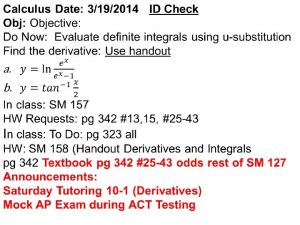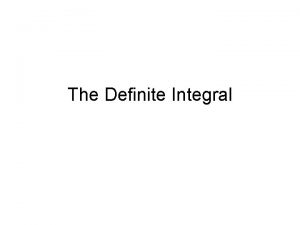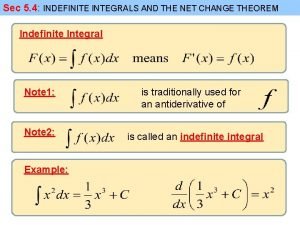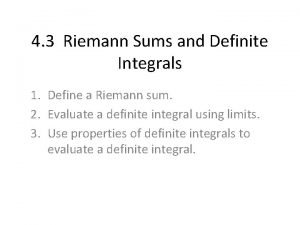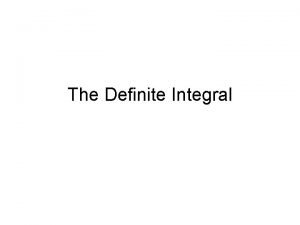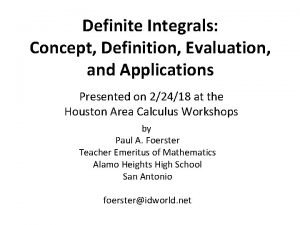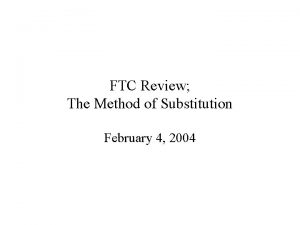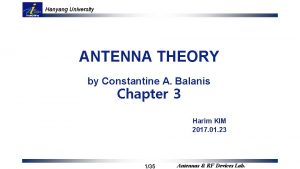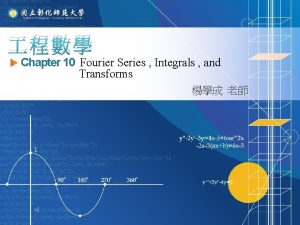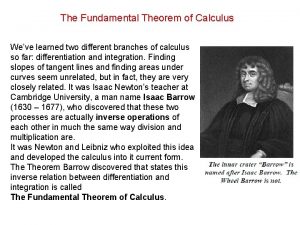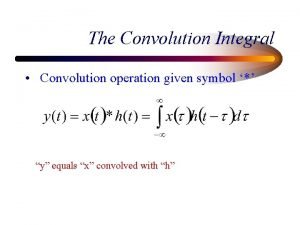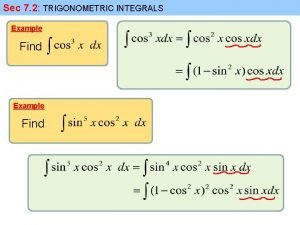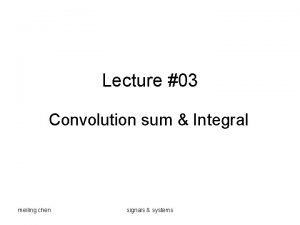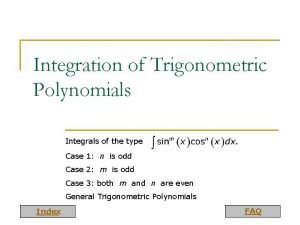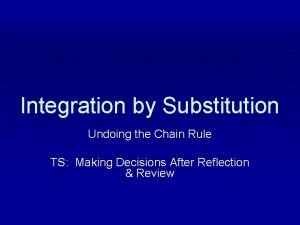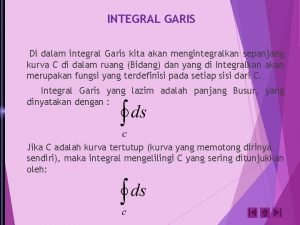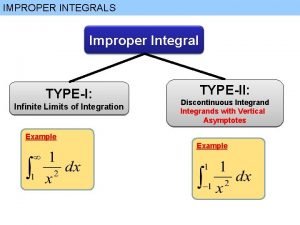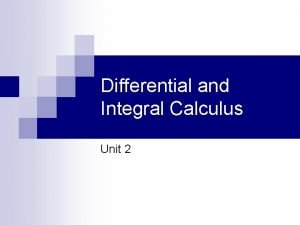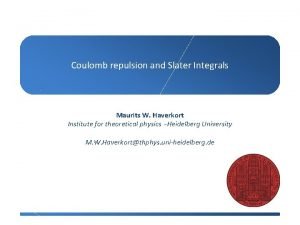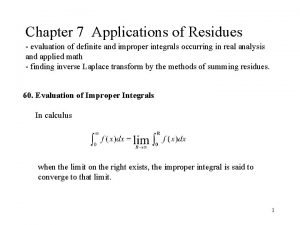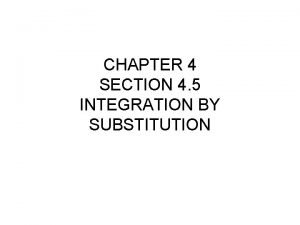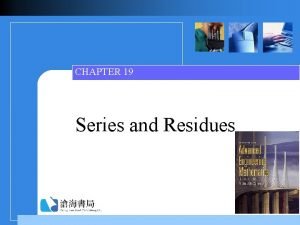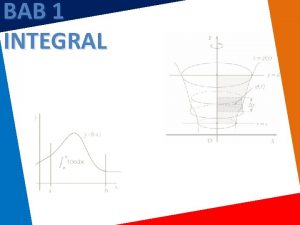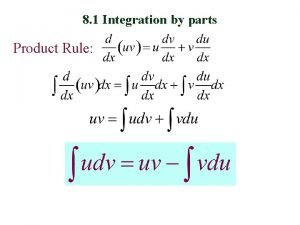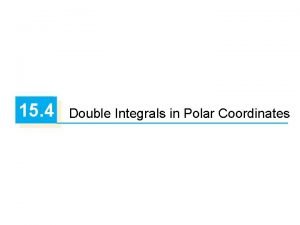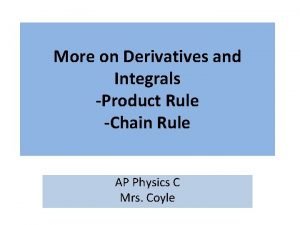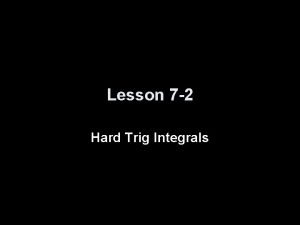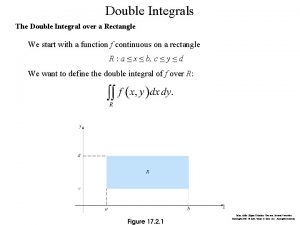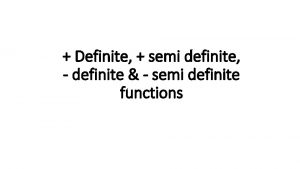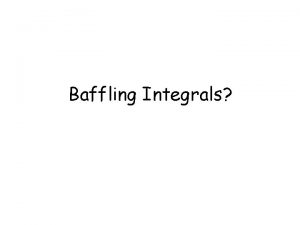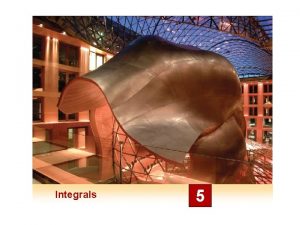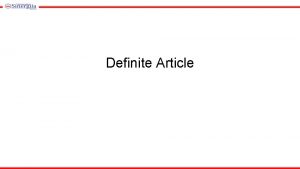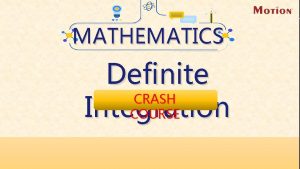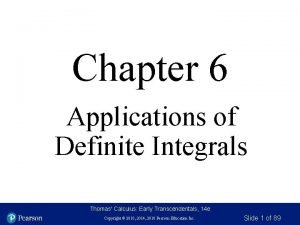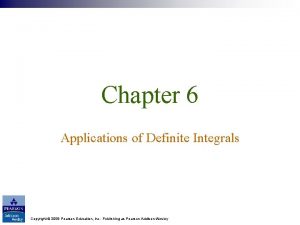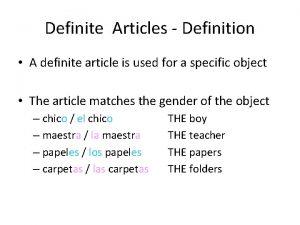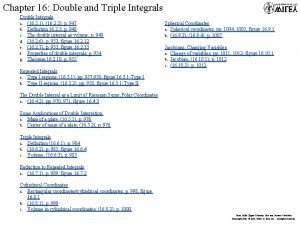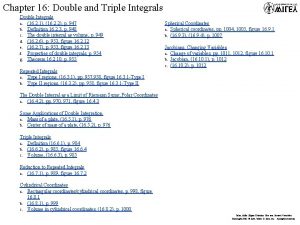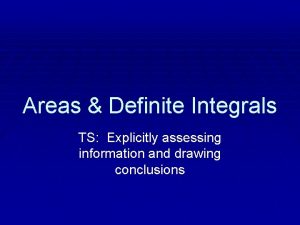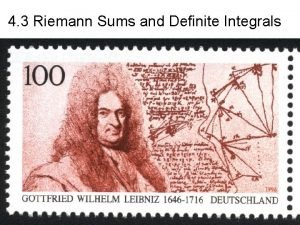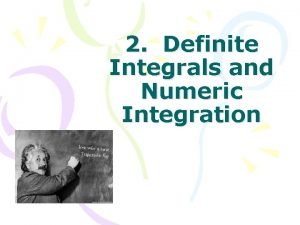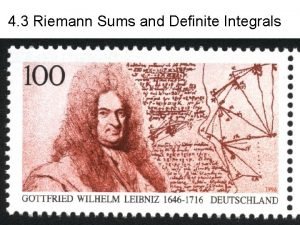Definite Integrals Concept Definition Evaluation and Applications Presented

































- Slides: 33

Definite Integrals: Concept, Definition, Evaluation, and Applications Presented on 2/24/18 at the Houston Area Calculus Workshops by Paul A. Foerster Teacher Emeritus of Mathematics Alamo Heights High School San Antonio foerster@idworld. net

What to Expect: “Explorations” used in class for your students First week activities leading to concept development Coffee break — 5 minutes Discovery and proof of the fundamental theorem Coffee break — 10 minutes Other forms of the fundamental theorem Which form of the FTC is best for which kind of application? Your final exam! (index card) Your reward: Solutions to all 14 Explorations

First day of calculus: Students hear about the four basic concepts: • Limits • Derivatives • Integrals Exploration 1 -1 a in groups: Rate (degrees/second) a door is moving at the instant one second after you push it open. Sketch a “reasonable graph. ” An instant is 0 s long. For 0 s, door moves 0˚, so inst. rate = 0/0 � Estimate inst. rate by finding average rates over shorter intervals. The limit of the average rates is called the derivative. On the second day: Exploration 1 -2 a, Review graphs of functions. • Quadratic • Exponential • Trigonometric • Rational >>---> No long precalculus review— works whatever text you use! On the third or fourth day: Students work in groups to find the distance, (rate)(time), a car goes if its rate varies.

Exploration 1 -3 a: Introduction to Definite Integrals Your car is going v(t) ft/s at t sec after you pass a truck. 1. How far did you go in the time interval [30, 50]? • (60 ft/s)(20 s) = 1200 ft 2. Explain why this number equals the area of a region under the graph. Sketch. • See figure. • Height = 60 • Base = 50 – 30 = 20 • Area = (20)(60) = 1200 >>---> Does it bother you that an area represents a distance?

3. Distance from 0 to 20 s also equals an area. How many squares? (one decimal place) • About 28. 6 squares 4. Small square area? Area of the region? How far did you travel? • 5 by 10 square: Area = 50. • (28. 6)(50) = 1430 • About 1430 feet (Exactly 1431. 4382…) 5. Units? Calculus concept? • Definite integral of v(t) with respect to t from t = 0 to t = 20. >>---> Definite integrals find y times x if y varies with x.

Exploration 1 -3 a (Problems 6 through 8) 6. Graph: Cross-sectional area of a football, y in. 2, at x in. from the football’s end. Find definite integral of y wrt x from x = 0 to 12. • ≈45. 2 squares. • 1 x 5 square: Area = 5 • Integral ≈ (45. 2)(5) = 226 (Exactly 226. 1946…) 7. Physical quantity represented by this integral? • Units: (in. 2)(in. ), which gives in. 3, i. e. cubic inches. • The volume of the football is about 226 in. 3 >>---> Integrals can be used to find volumes of solids! >>---> “Do we always have to count squares? ”

Exploration 1 -4 a: Definite Integrals by Trapezoidal Rule Rocket Problem: Graph, Ella Vader’s space ship’s velocity v(t) mi. /min. as a function of t. 1. Distance gone from t = 0 to 8? Concept used? • (rate)(time), rate varies • Definite integral 2. Estimate that distance. • ≈60. 8 sq. from t = 0 to 8. • 1 x 25 sq: area = 25. • Integral ≈ (60. 8)(25) = 1520 • Units: (mi. /min. )(min. ) = mi. • Distance ≈ 1520 mi. 3. Does the given graph agree with: • Plot on grapher and trace.

Rocket Problem, Continued: 4. Divide the region into four strips with vertical lines at t = 2, 4, 6, and 8. Form trapezoids by connecting the graph points. Estimate the integral with the trapezoid areas. • Integral ≈ 344 + 472 + 408 + 248 = 1472 (Why is this an underestimate? ) >>---> There is only one correct answer. (Easier to check their work!)

Rocket Problem concluded: (Problems 5, 6, 7) 5. Get a program to use this trapezoidal rule to estimate integrals. Input: (1) Equation for y = f(x), (2) starting and ending x-values, and (3) n, the number of trapezoids. Output: Estimate of the integral. Results: • n = 4: Integral ≈ 1472 (Ensures the program gives right answers. ) 6. • n = 20: Integral ≈ 1518. 08 7. • n = 40: Integral ≈ 1519. 52 • n = 100: Integral ≈ 1519. 99232 • n = 1000: Integral ≈ 1519. 999232 • Conjecture: Exact value of integral is 1520. >>---> Tentative Definition: A definite integral is the limit of the sum of the trapezoid areas as the number of trapezoids increases without bound.

Here’s what comes in the next couple months of calculus: Traditional algebraic (analytic) calculus topics. For each of the four concepts, students should be able to: • Apply it • Understand it • Define it • Do it I choose to expose students to the epsilon, delta definition of limit in a non-threatening way that also provides review of precalculus. Definition of Limit: L is the limit of f(x) as x approaches c if and only if for any positive number epsilon, no matter how small, there is a positive number delta such that if x is kept within delta units of c, but not equal to c, then f(x) stays within epsilon units of L. Note: Only words. Symbols will come later, when you’re “older. ” Exploration 2 -2 a shows how this can be done.

Exploration 2 -2 a: Definition of Limit 1. Write definition of: 2. Find max δ so f(x) stays within 1 unit of 7 if x is kept within δ units of 5. • ≈2. 4 on the left, ≈0. 9 on the right. • Max δ ? ≈ 0. 9 (why? ) 5. f(x) = 5 – 2(x – 6)1/3, x ≠ 5 Use precalc to calculate max δ. • δ = 0. 875 (≈0. 9 from graph. ) 7. Substitute (7 – ε) for f(x) and (5 + δ) for x. Solve for δ in terms of ε. Show that δ is positive for any positive ε, no matter how small ε is. • For small ε , (– 1 + 0. 5ε)3 is negative, but > – 1. So δ > 0, Q. E. D. >>---> Review of precalc while doing calculus. (No abs val. ineq. !)

These topics precede the return to definite integrals: • Limit theorems, including squeeze theorem and limit of a constant • Continuity and differentiability • Intermediate value theorem • Derivatives of polynomial, trig, inverse trig, composite (chain rule), products, quotients, exponential, logarithmic, and parametric functions, and implicit relations • Application to velocity, acceleration, and related rates problems Then the topic of definite integrals returns. • Differentials, and antiderivatives • Riemann sums, and the (actual) definition of definite integral • Preview of the fundamental theorem—Exploration 5 -4 b • Mean value theorem—Exploration 5 -5 a • Proof of the fundamental theorem—Explorations 5 -6 a and 5 -6 b

Exploration 5 -4 b: Fundamental Theorem of Calculus Preview 1. f(x) = x 1/2. Count squares to estimate • ≈4. 6 or 4. 7 2. Use midpoint Riemann sums: • M 10 = 4. 66760066… • M 100 = 4. 66667604… • M 500 = 4. 66666704… 3. Let Find g(4) – g(1). = 4. 6666… >>---> Remarkable! g(4) – g(1) seems to equal �� >>---> Can you calculate definite integrals using indefinite integrals? >>---> Could that be why they are both called “integrals? ”

Exploration 5 -5 a: The Mean Value Theorem (Problem 5) Secant thru pts. (5, h(5)), (7, h(7)) Is h differentiable on interval (5, 7)? Is h continuous on interval [5, 7]? Is there a point in the open interval (5, 7) where the tangent line at that point is parallel to the secant line? Explain. • No. Tangent lines have positive slope. Secant line has neg. slope. 8. (Now they learn what the mean value theorem states: ) Hypotheses: f differentiable on (a, b), continuous on [a, b] Conclusion: There is a point x = c in (a, b) where the instantaneous rate of change of f(x) equals the average (“mean”) rate of change.

Exploration 5 -6 a: Some Very Special Riemann Sums (#1, 2, 3, 4, 5) 1. f(x) = x 1/2 Use the FTC to evaluate 2. Trapezoidal Rule (n = 3): • T 3 = 4. 646264…, (underestimate) 3. Midpoint sum (n = 3): • M 3 = 4. 676712… (overestimate) 4. Riemann sum with these three sample points: c 1 = 1. 4858425557, c 2 = 2. 4916102607, c 3 = 3. 4940272163 • R 3 = 4. 66667 (rounded by calculator) (Between T 3 and M 3) 5. Riemann sum with these six sample points: c 1 = 1. 2458051304, c 2 = 1. 7470136081, c 3 = 2. 2476804000, c 4 = 2. 7481034438, c 5 = 3. 2483958517, c 6 = 3. 7486100806 • R 6 = 4. 66667 >>---> Rn seems to be independent of n. Is Rn is a constant?

Exploration 5 -6 a: (Continued — #6 and 7) 6. How did I calculate the sample points, e. g. c 1 = 1. 2458051304 ? Let g(x) be an indefinite integral of f(x) = x 1/2. Why does the mvt apply to function g on the interval [1, 1. 5] ? • g is differentiable on [1, 1. 5], and thus continuous on [1, 1. 5], and differentiable on (1, 1. 5), a subset of [1, 1. 5]. • Thus there is c 1 in (1, 1. 5) such that • c 1 = (1. 116156409…)2 = 1. 2458051304, as in Problem 5. 7. • For each interval, pick Riemann sum sample point for function f that is the mean value theorem point for function g. • Are the Riemann sums Rn really constant, independent of n?

Exploration 5 -6 b: Proof of the Fundamental Theorem of Calculus 1. Write the definition of definite integral. if both limits exist and are equal. (Ln and Un are lower and upper Riemann sums, respectively. ) 2. Write the definition of indefinite integral. if and only if 3. Explain why the mvt applies to function g. • g is differentiable b/c • Therefore g is continuous b/c 4. Write the conclusion of the mvt as it applies to g on [a, x 1], above. • There is a number c 1 in (a, x 1) such that

Exploration 5 -6 b, continued (Problems 5 and 6) write the terms for Rn • R n= 6. By the definition of indefinite integral, etc. By the mean value theorem, etc. The middle terms “telescope. ” >>---> Rn is a constant, independent of n, the no. of increments.

Exploration 5 -6 b, concluded (Problem 7) 7. Prove the fundamental theorem of calculus. i. e. , If then • Proof: Any Riemann sum is bounded by lower and upper sums. Take the limit of all three members. Limit of a constant is that constant. By the definition of definite integral. By the squeeze theorem. Rn = g(b) – g(a) >>---> Proof of FTC is short once you know the lemmas and definitions.

Other FTC Forms: (1) Functions Defined as Definite Integrals g(x) = area of region Let under graph of f(t) = sin t from t = 1 to t = x. By the FTC, (Why is derivative of cos 1 equal to 0? ) >>---> The derivative of a definite integral from a fixed lower limit to a variable upper limit = the integrand evaluated at the upper limit. >>---> The FTC in “derivative of an integral” form >>---> Length of strip = rate of change of area >>---> “The wider the paint brush, the faster the area of the painted region increases. ” Define: >>---> How does this definition imply that ln is a continuous function?

(2) Accumulated Rate of Change Form: Exploration 5 -10 c FTC: (Definite integral of a derivative) So: >>---> The fn inside the integral is the derivative of the fn outside. Using f instead of g: Algebra: Solve for f(b). >>---> Where f(x) winds up = where it starts + how much it changes. Similar to point-slope form of a linear function: Because f’(x) is the rate of change of f(x), can be called the Accumulated rate of change of f(x). 1. Find f(4) if f(1) = 13 and f’(x) = 3 x 2. >>---> Like a multiple-choice APE question

Exploration 5 -10 c (continued): (Problems 2 and 3) More APE-like problems: 2. The figure shows semicircular graph of f’(x). Find f(8) if f(2) = 7. = 13 + 4. 5π 3. Find h(a) if h(b) = 20 and • 20 = h(a) + 9 h(a) = 11 >>---> See the next slide for free-response type of APE problem.

Exploration 5 -10 c (concluded): (Problems 4 and 5) 4. C(x) = no. of customers in a supermarket x hours after opening. They arrive at instantaneous rates (customers/hour) of: If there are 83 customers at time x = 1, predict the number at x = 8. • Sketch the C’ graph. = 83 + 865 = 948 customers. Why “=, ” not “≈” in the last lines? 5. What is the real-world meaning of the integral in Problem 4? • The number of customers in the supermarket increased by 865 from time 1 to time 8 hours.

Application of the Riemann sum definition of definite integrals Volume of cylinder = (base area)(altitude) or (cross-sectional area)(altitude) What if the cross-sectional area varies with altitude? It is true, but not necessarily obvious, that cross-sectional area = rate of change of volume. Rather than using accumulated rate of change, try the “limit of a Riemann sum” definition. See Exploration 8 -4 a (next slide).

Exploration 8 -4 a: Volume of a solid by Riemann sum definition 1. The region in Q 1 above y = 0. 5 x 3 and below y = 4 is rotated about the y-axis. Volume = ? • Do geometry. Draw strip perp. to axis of rot. , and a sample pt. (x, y) on the graph in strip. Rotate the region. The strip generates a disk. Every y in the disk ≈ y at the sample point. Get volume d. V for the disk in terms of (x, y). d. V = (area)(thickness) = (πx 2)(dy) • Do algebra. Get d. V in terms of one variable. d. V = π(2 y)2/3 dy Use the relationship y = 0. 5 x 3. • Do calculus: Add the d. Vs and take the limit (i. e. , integrate). = 30. 1592… (3/5 vol. of cylinder!) >>---> “Volume problems” are mostly geometry and algebra.

Exploration 8 -4 a: Volume…(prob. 3 & 4) 3. Same solid, strip parallel to axis of rotation • Do geometry. Draw strip & sample pt. (x, y). Rotate region. Strip generates a cyl. shell. Every x in the strip ≈ x at the sample point Volume of shell: d. V = (area)(thickness) area = (circumference)(height) d. V = (2πx)(4 – y)(dx) in terms of sample pt. • Do algebra. Get d. V in terms of one variable. d. V = 2πx(4 – 0. 5 x 3) dx • Do calculus: Add the d. Vs and take the limit. = 9. 6π , same ans. >>---> The only difference is in the geometry, not the calculus.

Exploration 8 -4 a: Volumes (concluded) Problem 5 5. Rotate about line y = 1 the region bounded by x = 4 y – y 2, y-axis, line y= 1 Volume = ? Take strips of the region which way? • Perpendicular to axis of rotation? 0 ≤ x ≤ 3: Strip length (upper y) – (1) 3 ≤ x ≤ 4: Strip length (upper y) – (lower y) • Parallel to the axis of rotation. Every strip has length x – 0. • Rotation gives cylindrical shells. • Homework: Show that V = 22. 5π. >>---> Focus on how you draw the strip and what it generates.

Exploration 5 -9 e: Volume Game! (Problem 5) 5. The region in Q 1 bounded by y = cos x forms the base of a solid. Cross-sections perpendicular to x-axis are isosceles right triangles. Volume = ? • Do geometry: Draw slice & sample pt. All points in the slice have ≈ the same x as at sample pt. (x, y). d. V = (area)(thickness) in terms of (x, y). • Do algebra. Get d. V in terms of one variable. • Do calculus: Add the d. Vs and take the limit. = 0. 3926… = π/8 >>---> See similarities among these volume problems? >>---> Don’t say “disc method, washer method, shell method, …. ”

Exploration 11 -1 a: Chair Work Problem Find work W done pushing a chair 7 feet with variable force F pounds • Do physics. Work = force x displacement But the force varies. Let d. W be work done moving chair dx ft. • Do geometry: Show a sample point (x, F). For small dx, F ≈ F at the sample point. d. W = F dx (d. W in terms of sample pt. ) • Do algebra: d. W in terms of one variable. • Do calculus: Add the d. Ws, take limit. = 69. 1289… ≈ 69. 1 ft-lb (Why “foot-pounds? ”) >>---> It’s not obvious that force = rate of change of work.

Exploration 11 -1 a, Chair Work Problem Integral (Again) Just for fun, do the integration algebraically (analytically). Integral of a product. 1. Must be able to integrate dv. Integration by parts 2. Should get better, not worse. = 69. 1289… ≈ 69. 1 ft-lb (Same answer!) >>---> Reasons to learn how to integrate by parts (1) Derivative of a product, so integral of a product. (2) Differentiate and integrate in the same problem. (3) It’s easy to do if you use the table method.

Exploration 11 -3 a: Mass of a Variable-Density Solid (Problem 1) 1. Solid paraboloid: Rotate y = x 2 about y-axis. Density ρ varies axially (“in the direction of the axis”) At sample pt. (x, y), ρ = 3 y 1/2 g/cm 3. Mass m =? • Do physics: Mass = (density)(volume) • Do geometry: Slice solid perp. to axis of rot. ρ at each point in slice ≈ ρ at the sample point (x, y). dm = (ρ)(d. V) (Mass dm of slice in terms of density and volume) d. V = πx 2 dy , so dm = (ρ)(πx 2 dy) (dm in terms of sample point) • Do algebra: Get dm in terms of one variable. • Do calculus: Add up the dms and take limit. = 38. 4π = 120. 6371… ≈ 120. 6 g

Exploration 11 -3 a: Concluded (Problem 2) 2. Same solid, but the density varies radially. On the parabola y = x 2, ρ = (x + 5) g/cm 3 at the sample point (x, y). Mass m =? • Do physics: dm = ρ d. V • Do geometry: Slice into cylindrical shells. ρ at each point shell ≈ ρ at the sample pt. (dm in terms of sample point (x, y) • Do algebra: (one variable) • Do calculus: Add the dms and take the limit. >>---> Would be hard to analyze by accumulated rate of change. It’s not obvious that the integrand is the rate of change of mass.

Conclusions: 1. The course can start with calculus on Day 1 rather than review. 2. “Definition” vs. “Understanding” vs. “Calculation method” 3. Students can understand proof of the FTC if done appropriately. 4. Other forms of the FTC are just algebraic rearrangements. 5. “Accumulated rate” form: If rate is known (e. g. differential eqns. ) 6. “Riemann sum” form: More general for “x times y where y varies. ” 7. Volume problems differ only in geometry, not calculus. 8. Integration by parts is worth teaching. Foerster: Calculus: Concepts and Applications The leaflet describes the book, its ancillary materials, and free on-line 30 -day trial, with all 150+ Explorations, including the ones in this workshop. Go to: www. flourishkh. com Final Exam! On the index card, write the one most important thing you learned as a result of participating in this workshop.
 Substitution rule
Substitution rule Riemann sum sigma notation
Riemann sum sigma notation Definite integral vs indefinite integral
Definite integral vs indefinite integral Definite integrals as a limit of a sum
Definite integrals as a limit of a sum Max min inequality definite integrals
Max min inequality definite integrals Exploration 1-3a introduction to definite integrals
Exploration 1-3a introduction to definite integrals Circuit training properties of definite integrals
Circuit training properties of definite integrals Radiation integrals and auxiliary potential functions
Radiation integrals and auxiliary potential functions Fourier series of even and odd functions
Fourier series of even and odd functions Integrals involving powers of secant and tangent
Integrals involving powers of secant and tangent Calculus theorems
Calculus theorems Integral convolution
Integral convolution Sec 7
Sec 7 Properties of indefinite integrals
Properties of indefinite integrals Convolution sum and convolution integral
Convolution sum and convolution integral Integral trig identities
Integral trig identities U substitution
U substitution Contoh soal integral permukaan
Contoh soal integral permukaan Integral garis dengan kurva tertutup
Integral garis dengan kurva tertutup Improper integral
Improper integral Rate of change examples
Rate of change examples Slater integrals
Slater integrals Application of residue theorem to evaluate real integrals
Application of residue theorem to evaluate real integrals Calculus chapter 5
Calculus chapter 5 Chain rule integration
Chain rule integration Application of residue theorem to evaluate real integrals
Application of residue theorem to evaluate real integrals Peta konsep integral
Peta konsep integral Product rule for integrals
Product rule for integrals Polar integrals
Polar integrals Change of variables multiple integrals
Change of variables multiple integrals Properties of double integrals
Properties of double integrals Integral product rule
Integral product rule Hard trig integrals
Hard trig integrals Double integral over rectangle
Double integral over rectangle
